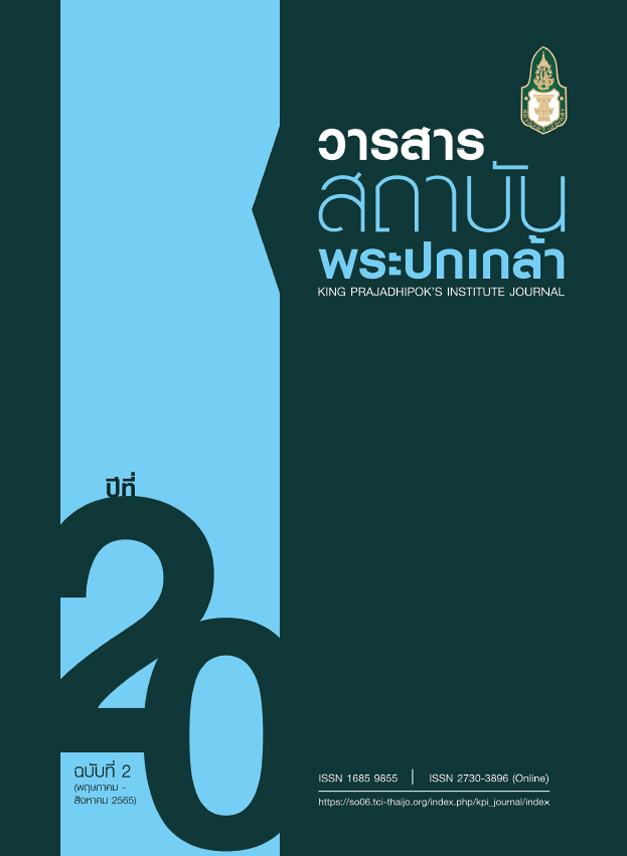Raising the Minimum Wage to a Living Wage Collaborative Research Lesson with the Committee of Labor
Main Article Content
Abstract
The idea of a minimum wage is considered based on human rights guarantees that individuals and families have an adequate income. The background of the research is for labor networks in various industries to submit a letter to the chairperson of the Committee on Labor because the government has not raised the minimum wage rate in at least two years and people are having problems keeping up with the rising cost of living. The study's purpose is to examine the current state of living costs and construct an argument for recommending a path to achieving a decent standard of living. Following that, the Labor Committee decided to organize a working group to study wage and cost of living issues. The working group's participation in all stages, such as brainstorming, designing a questionnaire, reflecting on viewpoints, collecting data, and analyzing survey data, is covered by the research method. The findings and recommendations in this article suggest that the minimum wage definition should be changed to include a living wage, and the wage rate should be altered to match living costs. If the government is unable to adjust the level of the living wage, public sector agencies involved in the problem must implement social protection policies and provide assistance to low-paid workers earning less than the living wage. Furthermore, minimum wage legislation is a matter of collective bargaining, not universal mathematics. The fundamental issue is the tripartite structure, which is exacerbated by the failure to ratify ILO Conventions No. 87 and 98, resulting in a lack of legal protection for workers' associations.
Article Details

This work is licensed under a Creative Commons Attribution-NonCommercial-NoDerivatives 4.0 International License.
@ 2020 King Prajadhipok's Institute The Government Complex Commemorating All Right Reserved.
References
ภาษาไทย
กระทรวงแรงงาน. (2553). สถานการณ์แรงงานไตรมาส 1 ปี 2553. สืบค้นจาก https://bit.ly/3xoPoBI
. (2565). คณะกรรมการสมานฉันท์แรงงานไทยเข้าพบรัฐมนตรีว่าการกระทรวงแรงงานให้พิจารณาปรับอัตราค่าจ้างขั้นต่ำ เมื่อวันที่ 24 มกราคม 2565. สืบค้นจาก https://bit.ly/38Otr5M
กรุงเทพธุรกิจ. (2565). นายจ้าง ‘ช็อก’ ค่าจ้าง 492 บาท ทั่วประเทศ !. สืบค้นจาก https://bit.ly/3wVaeaf
ขวัญกมล ถนัดค้า และแมกซ์ นอย. (2561). ปรับเพิ่มค่าจ้างขั้นต่ำอัตโนมัติ ดีอย่างไร?. สืบค้นจาก https://bit.ly/3wV0Jbl
คณะกรรมการค่าจ้างขั้นต่ำ. (2563). คำชี้แจงประกาศคณะกรรมการค่าจ้าง เรื่อง อัตราค่าจ้างขั้นต่ำ (ฉบับที่ 10). สืบค้นจาก https://bit.ly/3wQ9DGR
คณะกรรมาธิการการแรงงาน สภาผู้แทนราษฎร. (2565ก). สรุปการประชุมคณะกรรมาธิการการแรงงาน สภาผู้แทนราษฎร ครั้งที่ 66 วันพฤหัสบดีที่ 20 มกราคม 2565 ณ ห้องปะชุมกรรมาธิการการแรงงาน CA 408 ชั้น 4 อาคารรัฐสภา. สืบค้นจาก https://bit.ly/3Q1WfZ3
. (2565ข). สรุปผลการประชุมคณะกรรมาธิการการแรงงาน สภาผู้แทนราษฎร ครั้งที่ 72 วันพุธที่ 25 พฤษภาคม 2565 ณ ห้องปะชุมกรรมาธิการการแรงงาน CA 318 ชั้น 3 อาคารรัฐสภา. สืบค้นจาก https://bit.ly/3xnmK3S
ธนาคารแห่งประเทศไทย. (2565). ยอดคงค้างเงินรับฝากแยกตามขนาดและอายุของเงินฝากของธนาคารพาณิชย์จดทะเบียนในประเทศ. สืบค้นจาก https://bit.ly/35Knzcb
เนชั่นทีวี. (2565). "สุชาติ" ยันค่าแรงขั้นต่ำปรับแน่ แต่ไม่ใช่ 492 บาท. สืบค้นจาก https://bit.ly/3lPQD6s
ปกป้อง จันวิทย์ และพรเทพ เบญญาอภิกุล. (2556). โครงการวิจัยเรื่องอัตราค่าจ้างขั้นต่ำที่เหมาะสมสำหรับประเทศไทยและผลกระทบต่อเศรษฐกิจส่วนรวม. สืบค้นจาก https://bit.ly/3PGtYr3
ประกาศคณะกรรมการค่าจ้าง เรื่อง อัตราค่าจ้างขั้นต่ำ (ฉบับที่ 8). (2559, 7 ธันวาคม).
ราชกิจจานุเบกษา. เล่ม 133 ตอนพิเศษ 284 ง. สืบค้นจาก https://bit.ly/3Et44lr
ประกาศคณะกรรมการค่าจ้าง เรื่อง อัตราค่าจ้างขั้นต่ำ (ฉบับที่ 9). (2561, 19 มีนาคม).
ราชกิจจานุเบกษา. เล่ม 135 ตอนพิเศษ 63 ง. สืบค้นจาก https://bit.ly/3KHuUbF
ประกาศคณะกรรมการค่าจ้าง เรื่อง อัตราค่าจ้างขั้นต่ำ (ฉบับที่ 10). (2562, 27 ธันวาคม).
ราชกิจจานุเบกษา. เล่ม 136 ตอนพิเศษ 316 ง. สืบค้นจาก https://bit.ly/3vhxr5J
สำนักงานคณะกรรมการค่าจ้าง. กองเศรษฐกิจการแรงงาน. (2564). คู่มือการปฏิบัติงานของสำนักงานคณะกรรมการค่าจ้าง. สืบค้นจาก https://bit.ly/3jw8Gxv
สำนักงานสถิติแห่งชาติ. (2564). สรุปผลที่สำคัญการสำรวจภาวะเศรษฐกิจและสังคมของครัวเรือน ในช่วง 6 เดือนแรกของปี 2564. สืบค้นจาก https://bit.ly/38oqMiV
วีระยุทธ ลาสงยาง, พินิจ ทิพย์มณี และวิจิตรา วิเชียรชม. (2563). มาตรการทางกฎหมายในการกำหนดอัตราค่าจ้างขั้นต่ำเพื่อพัฒนาแรงงานในประชาคมเศรษฐกิจอาเซียน. วารสารนิติศาสตร์และสังคมท้องถิ่น, 4(2), 61-83.
อรรถกฤต ปัจฉิมนันท์. (2558). นโยบายค่าจ้างแรงงานขั้นต่ำและการพัฒนาทางเศรษฐกิจในระยะยาว : กรณีศึกษาประเทศไทย. วารสารสถาบันพระปกเกล้า, 13(2), 113-144.
ภาษาอังกฤษ
Anker, R. & Anker, M. (2017). Living Wages Around the World: Manual for Measurement. Cheltenham: Edward Elgar Publishing.
Global Living Wage Coalition. (2018). The Anker Methodology for Estimating a Living Wage. Retrieved from https://bit.ly/3awBKng
International Organisation of Employers (IOE). (2014). Guidance Paper of the International Organisation of Employer. Retrieved from https://bit.ly/3JqHgn8
International Labor Office (ILO). (2016). Chapter 1 – How to define a Minimum Wage?. In Minimum Wage Policy Guide. Retrieved from https://bit.ly/3vj8XZV
. (2020). Global Wage Report 2020-21: Wages and Minimum Wages in the Time of COVID-19. Retrieved from https://bit.ly/3MaF3hv
ILO NORMLEX. (1949). C095 - Protection of Wages Convention, 1949 (No. 95). Retrieved from https://bit.ly/3JCwBpj
. (1970). C131 - Minimum Wage Fixing Convention, 1970 (No. 131). Retrieved from https://bit.ly/3O7rLnL
Yoelao, D., Sombatwattana, P., & Mohan, K. P. (2021). Development and Validation of the Sufficiency Living Wage Scale for Workers in Thailand. Thailand and The World Economy, 39(1), 23-38.
World Bank. (2022). Inflation, consumer prices (annual %) – Thailand. Retrieved from https://bit.ly/3PNAiNt


